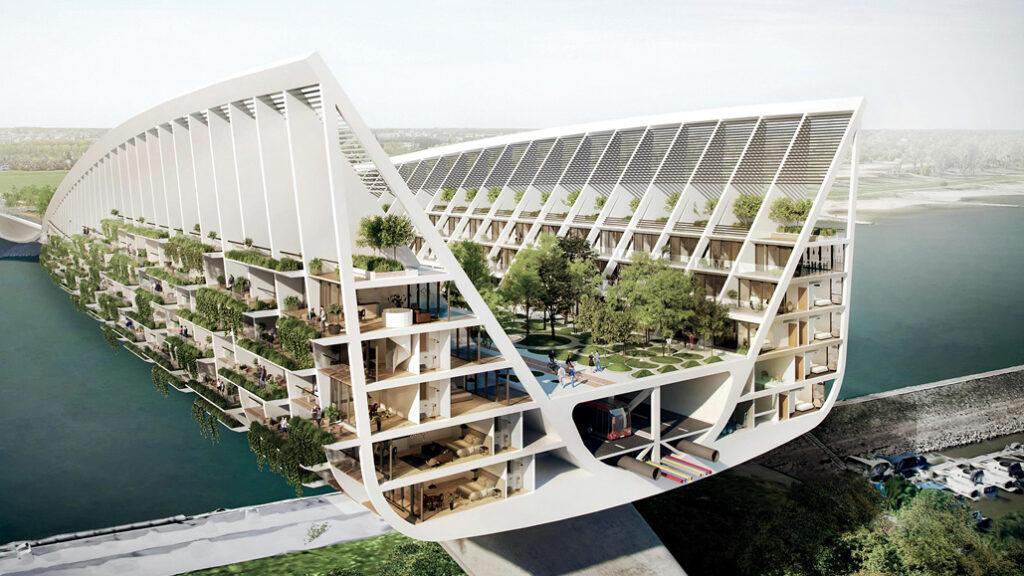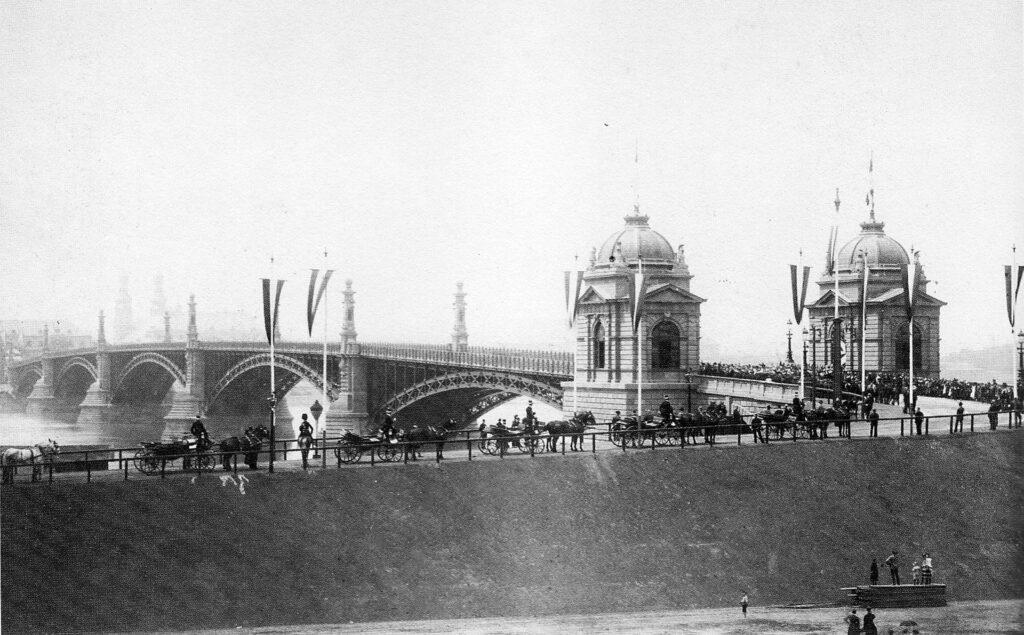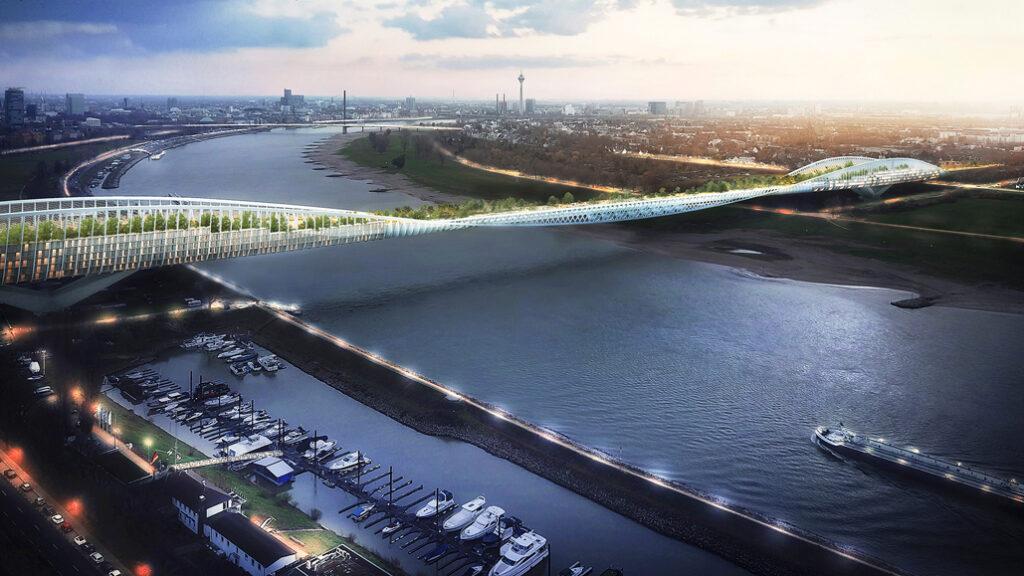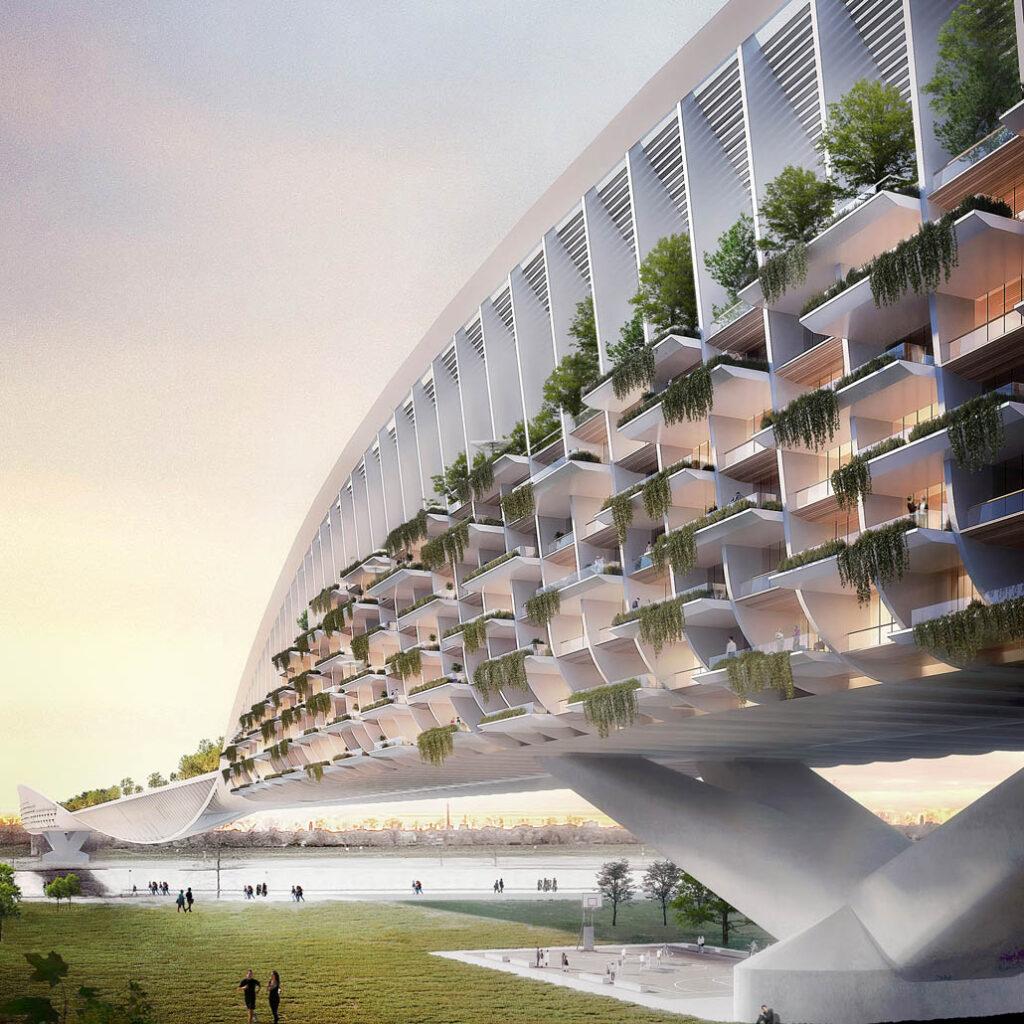A bridge to the future
As Dusseldorf’s Theodor Heuss Bridge needs a complete overhaul, the team at RKW Architektur + put their heads together – and produced a spectacular new design. It is literally packed with potential.
The word itself is associated with more than just the name of a structure. Bridge. Admittedly, it does conjure up images of Golden Gate Bridge or Rialto Bridge first and foremost. But then again, there are bridge-builders in another sense, too – famous people like Mikhail Gorbachev, Angela Merkel and Nelson Mandela.
The bridge. It links up worlds that were previously separate. At all times, in any context. Truly inspiring.
Theodor Heuss Bridge, reimagined
German architectural firm RKW wants to build a bridge in both senses, both metaphorically and materially. But let’s start at the beginning. Originally constructed in 1957 with a length of 1.3 kilometres, Theodor Heuss Bridge in Dusseldorf is undoubtedly in need of reconstruction. And so these resourceful architects decided to submit an on-spec design.
In other words, they chose to present a proposal for the ailing Theodor Heuss Bridge of their own accord. Without anybody asking for it. Their motivation will have been to preempt a simple renovation, and demonstrate that this structure can achieve more than just bridging the gap between the banks of the Rhine. Instead, it can forge a link with a green future.
The makings of a real green bridge
The title of the concept alone – Green Bridge Dusseldorf – makes this objective quite clear. To a certain extent, their basic message is taken from a quote by legendary architect Adolf Loos: “A change that is not an improvement is a degradation”. That is to say, simply renovating the old bridge basically means zero progress.
And so the RKW architects are convinced that it’s better to demolish it and build a totally new one. To lend extra weight to their idea, they linked up with Marcel Abel, a renowned expert in urban development and managing director at property specialist Jones Lang LaSalle (JLL).
More than just a bridge
In any case, they issued a joint statement: “The bridge has to be rebuilt anyway, but nowadays much more can be made of such a development than just a traffic route. Instead, it can be a sustainable structure that gives people quality space in a prime location.”
And so it is possible to make a bridge into more than just a connection between two geographical points. “We have developed the idea of the ‘Green Bridge’ to combine many different functions and offerings,” explains Jabra Soliman, associate partner at RKW.
For instance, motorized traffic crosses the Rhine through a tunnel on the bridge, instead of being exposed on the surface. The resulting corridor opened up by the architects has been reserved for cyclists, pedestrians and a wealth of lush greenery. And the mega-tall pylons typical of a cable-stayed bridge have been reimagined with more than just their static function in mind. The result is usable architecture as a replacement.
Stylish living above the Rhine
In other words, around 400 homes – ranging from tiny apartments to maisonettes – are on offer at the sides of the bridge. “There is a combination of state- and privately-funded living space. This creates vibrant neighbourhoods with many generations all coming together, either very close to or directly above the water,” according to the official press release.
Rest and relaxation on your doorstep
What’s really appealing about this project is that you can kick off your shoes when you come home and relax “on deck”: Cyclists will enjoy the track through the green spaces on the bridge, where barbecue areas and play areas overlook the cityscape. Newsagents and cafés enhance the facilities on offer, while urban gardening and farming projects are also conceivable. In addition, wind turbines and solar panels are naturally integrated into the structure, which is 47 metres high in places.
At all events, Marcel Abel from JLL is distinctly confident about the project: “We will give the city fresh momentum by creating links between transport and sustainability, recuperation and impact. The Green Bridge can set standards that transcend the borders of Germany, which reflects well on Dusseldorf as a city. And so we will use our resources and networks to bring this project to fruition.”
Climate targets, here we come!
As the city’s sights are focused on its climate targets, the architects want to use the bridge to make another contribution towards climate neutrality.
RKW shareholder Dieter Schmoll summarizes: “Besides the extensive, specific offerings such as a park with leisure areas and the new cycle path, the housing and hotel, and also offices, the new bridge has even further potential, which is not to be underestimated: the Dusseldorf ‘Green Bridge’ can set standards in the revitalization of engineered structures and become a landmark for the regional capital, visible for miles around.”
The Green Bridge can set standards that transcend the borders of Germany, which reflects well on Dusseldorf as a city.
Marcel Abel, JLL
Whatever happens, this sounds like a spectacular project. According to the initiators, it could be finished within four years. At a cost of around 700 million euros.
So now it’s simply a matter of bridging the gap in its financing. And as long as that remains unsolved, this attractive project will be left hanging midair.
Text: Johannes Stühlinger
Translation: Rosemary Bridger-Lippe
Images: formtoo; Wikipedia



